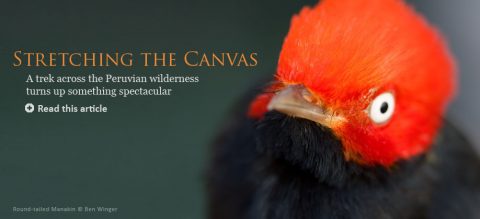Live from the AOU Meeting
by Mike Webster
April 15, 2010

In the last few days, I’ve been amazed by talks from the new generation of up-and-coming ornithologists, who are undertaking dissertations at a level of detail that once would have taken an entire career.
Take Great Frigatebirds. Frans Juola, a Ph.D. student at the University of Miami, wondered how and why females select their mates. Many researchers probably would focus on the giant red air sac (gular pouch) that males of this species inflate to attract females. But Frans noticed that females spend a lot of time nuzzling up with potential mates and wondered if perhaps these females might pick up much more subtle cues.
In particular, Frans wondered if females select males based on the types of genes they have in a portion of their DNA known as the MhC—a genetic complex known to be important in defenses against disease. Mammals, including humans, choose mates whose MhC complex is very different from their own. Could frigatebirds be doing this as well?
Using new molecular techniques, Frans determined the MhC genes for 46 frigatebird pairs, and then compared females to their mates. As is often the case in research, his first comparison didn’t reveal much: females and their mates were no more different from each other than randomly selected pairs. But Frans realized that, because of the way genes get translated into proteins in the body, only some of those genetic differences would actually affect the MhC’s function. When he narrowed his focus to just those meaningful genetic changes, paired males and females differed from each other much more than would be expected by chance. And so it appears that female frigatebirds do actively choose males based on their MhC genotype.
Zachary Cheviron, a recent Ph.D. graduate from UCLA, presented another astounding study. Zach wondered how some birds manage to live at very high elevations, in extreme cold and very thin air. Zach investigated hemoglobin, the blood protein that carries oxygen, in the wide-ranging Rufous-collared Sparrow of South America. He learned that sparrows living high in the Andes had different hemoglobin that bound oxygen more strongly than in their lowland relatives.
Zach then traced the difference back to the gene that codes for hemoglobin, and found that the difference stems from a single mutation in the sparrow’s DNA. The gene shows signs of strong selection favoring one type of hemoglobin at high altitudes and the other at low altitudes. Thus, he has uncovered a wonderful story of how birds adapt to their local environment, and has traced this adaptation right back to the level of the genes involved.
These are just two examples of fascinating studies presented at the AOU meeting— others abound here: advances in electronic monitoring, satellite tracking, physiology, and even mathematics all put to use in advancing biology and conservation. Taken together, it is astounding—and exciting—to see how innovative young scientists are using modern research tools to answer ever-more intricate questions.
—Mike Webster
To read the complete blog posts about the 2010 joint meeting of the American Ornithologists’ Union, Cooper Ornithological Society, and Society of Canadian Ornithologists, browse through our posts from February 9–17, 2010 at our blog, Round Robin.


All About Birds is a free resource
Available for everyone,
funded by donors like you







